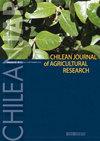Detoxified castor-bean meal replaces soybean meal in the diet of pasture-finished steers
IF 1.7
4区 农林科学
Q2 Agricultural and Biological Sciences
引用次数: 2
Abstract
The use of agroindustrial byproducts in cattle diets, such as castor-bean ( Ricinus communis L.) meal, is a more sustainable practice because it does not compete with human food and reduces the volume of organic waste deposited in the environment. The aim of this study was to examine the effect of replacing soybean ( Glycine max (L.) Merr.) meal with castor-bean meal on the intake, digestibility, feeding behavior and performance of crossbred steers supplemented while on Urochloa brizantha (Hochst. ex A. Rich.) R.D. Webster ‘Marandu’ pasture. The experiment was laid out in a randomized complete design with 40 animals, which started the experiment weighing 227.1 kg, at 10 mo of age, and were divided into four treatment groups. Castor-bean meal was added to replace soybean meal at the levels of 0, 90, 180, and 280 g kg -1 in the supplement, which was supplied at the rate of 0.4% of body weight. Total DM, pasture DM and neutral detergent fiber intakes did not change (P > 0.05) with the castor-bean levels added to the supplement. Ether extract intake and digestibility decreased linearly (P < 0.05). The animals showed no differences (P > 0.05) in production performance (average daily gain), which averaged 0.65 kg d -1 . Grazing, idle, and rumination times were not influenced (P > 0.05) by the treatments. Castor-bean meal can be included up to 280 g kg -1 in the total diet without changing the performance of crossbred steers finished on tropical pasture.牧场肥牛日粮中脱毒蓖麻粕替代豆粕
在牛的饮食中使用农业工业副产品,如蓖麻粉,是一种更可持续的做法,因为它不会与人类食物竞争,并减少了沉积在环境中的有机废物的数量。本研究的目的是检验替代大豆(Glycine max(L.)Merr.)的效果蓖麻豆粕对杂交牛在乌罗奇洛阿(Hochst.ex A.Rich.)R.D.Webster‘Marandu’牧场补充的采食量、消化率、饲养行为和性能的影响。实验采用随机完全设计,共有40只动物,在10个月大时开始实验,体重227.1公斤,分为四个治疗组。以0、90、180和280 g kg-1的水平添加蓖麻豆粕代替豆粕,补充量为体重的0.4%。总DM、牧场DM和中性洗涤纤维摄入量随添加蓖麻豆水平的增加而无变化(P>0.05)。乙醚提取物摄入量和消化率呈线性下降(P<0.05),动物生产性能(平均日增重)无差异(P>0.05),平均日增重0.65kg。放牧、闲置和反刍时间不受处理的影响(P>0.05)。在不改变在热带牧场上完成的杂交牛的性能的情况下,总日粮中可包含高达280 g kg-1的蓖麻豆粕。
本文章由计算机程序翻译,如有差异,请以英文原文为准。
求助全文
约1分钟内获得全文
求助全文
来源期刊
CiteScore
3.00
自引率
11.80%
发文量
60
审稿时长
6 months
期刊介绍:
ChileanJAR publishes original Research Articles, Scientific Notes and Reviews of agriculture, multidisciplinary and agronomy: plant production, plant protection, genetic resources and biotechnology, water management, soil sciences, environment, agricultural economics, and animal production (focused in ruminant feeding). The editorial process is a double-blind peer reviewing, Editorial Office checks format, composition, and completeness, which is a requirement to continue the editorial process. Editorial Committee and Reviewers evaluate relevance and scientific merit of manuscript.

 求助内容:
求助内容: 应助结果提醒方式:
应助结果提醒方式:


